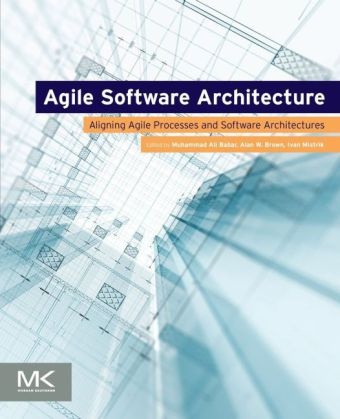Read more
Informationen zum Autor Dr. M. Ali Babar is a Professor of Software Engineering (Chair) at the School of Computer Science, the University of Adelaide, Australia. He also holds an Associate Professorship at IT University of Copenhagen, Denmark. Prior to this, he was a Reader in Software Engineering at Lancaster University UK. Previously, he worked as a researcher and project leaders in different research centres in Ireland and Australia. He has authored/co-authored more than 140 peer-reviewed research papers in journals, conferences, and workshops. He has co-edited a book, software architecture knowledge management: theory and practice. Prof. Ali Babar has been a guest editor of several special issues/sections of IEEE Software, JSS, ESEJ, SoSyM, IST, and REJ. Apart from being on the program committees of several international conferences such as WICSA/ECSA, ESEM, SPLC, ICGSE, and ICSSP for several years, Prof. Ali Babar was the founding general chair of Nordic-Baltic Symposium on Cloud Computing and Internet Technologies (NordiCloud) 2012. He has also been co-(chair) of the program committees of several conferences such as NordiCloud 2013, WICSA/ECSA 2012, ECSA2010, PROFES2010, and ICGSE2011. He is a member of steering committees of WICSA, ECSA, NordiCloud and ICGSE. He has presented tutorials in the areas of cloud computing, software architecture and empirical approaches at various international conferences. Prior to joining R&D field, he worked as a software engineer and an IT consultant for several years in Australia. He obtained a PhD in computer science and engineering from University of New South Wales, Australia. Alan W. Brown is Professor of Entrepreneurship and Innovation in the Surrey Business School, University of Surrey, UK. where he leads activities in the area of corporate entrepreneurship and open innovation models. In addition to teaching activities, he focuses on innovation in a number of practical research areas with regard to global enterprise software delivery, agile software supply chains, and the investigation of "open commercial" software delivery models. He has formerly held a wide range of roles in industry, including Distinguished Engineer and CTO at IBM Rational, VP of Research at Sterling Software, Research Manager at Texas Instruments Software, and Head of Business Development in a Silicon Valley startup. In these roles Alan has worked with teams around the world on software engineering strategy, process improvement, and the transition to agile delivery approaches. He has published over 50 papers and written four books. He holds a Ph.D. in Computing Science from the University of Newcastle upon Tyne, UK. Ivan Mistrik is a computer scientist who is interested in system and software engineering (SE/SWE) and in system and software architecture (SA/SWA), in particular: life cycle system/software engineering, requirements engineering, relating software requirements and architectures, knowledge management in software development, rationale-based software development, aligning enterprise/system/software architectures, and collaborative system/software engineering. He has more than forty years’ experience in the field of computer systems engineering as an information systems developer, R&D leader, SE/SA research analyst, educator in computer sciences, and ICT management consultant. In the past 40 years, he has been primarily working at various R&D institutions and has done consulting on a variety of large international projects sponsored by ESA, EU, NASA, NATO, and UN. He has also taught university-level computer sciences courses in software engineering, software architecture, distributed information systems, and human-computer interaction. He is the author or co-author of more than 80 articles and papers in international journals, conferences, books and workshops, most recently a chapter Capture of Software Requirements and Rationale through Collaborative Software Development, ...
List of contents
Chapter 1: Introduction to ASA
ASA: The State-of-the-Art
ASA: Industrial/commercial perspective
ASA: Current Challenges and Future Directions
Part I: Fundamentals of Agile Architecting
Chapter 2: The DCI Paradigm: Beyond Class-Oriented Architecture to Object Orientation
Chapter 3: Refactoring software architecture
Chapter 4: Architecture Decisions: Who, How and When?
Part II: Managing Software Architecture in Agile Projects
Chapter 5: Combining agile development and variability handling to achieve adaptable software architectures
Chapter 6: Agile software architecture knowledge management
Chapter 7: Continuous software architecture analysis
Chapter 8: Bridging user stories and software architectures: a guidance support for agile architecting
Part III: Agile Architecting in Specific Domains
Chapter 9: Architecture-centric testing for security: An agile perspective
Chapter 10: Multi-tenancy multi-target architectures: Extending multi-tenancy architectures for agile deployment and development
Part IV: Industrial Viewpoints on Agile Architecting
Chapter 11: Bursting the Agile Bubble Anti-Pattern
Chapter 12: Building a Platform for Innovation: Architecture and Agile as Key Enablers
Chapter 13: Opportunities, threats and limitations of emergent architecture
Chapter 14: Aviva GI: Architecture as a Key Driver for Agile Success
Report
"Project managers, product owners, and software architects will benefit from reading this book. They will be able to check what is the state of the art and how to apply specific techniques to their own projects given different dimensions, domains, and scopes. " --ComputingReviews.com, August 6 2014

